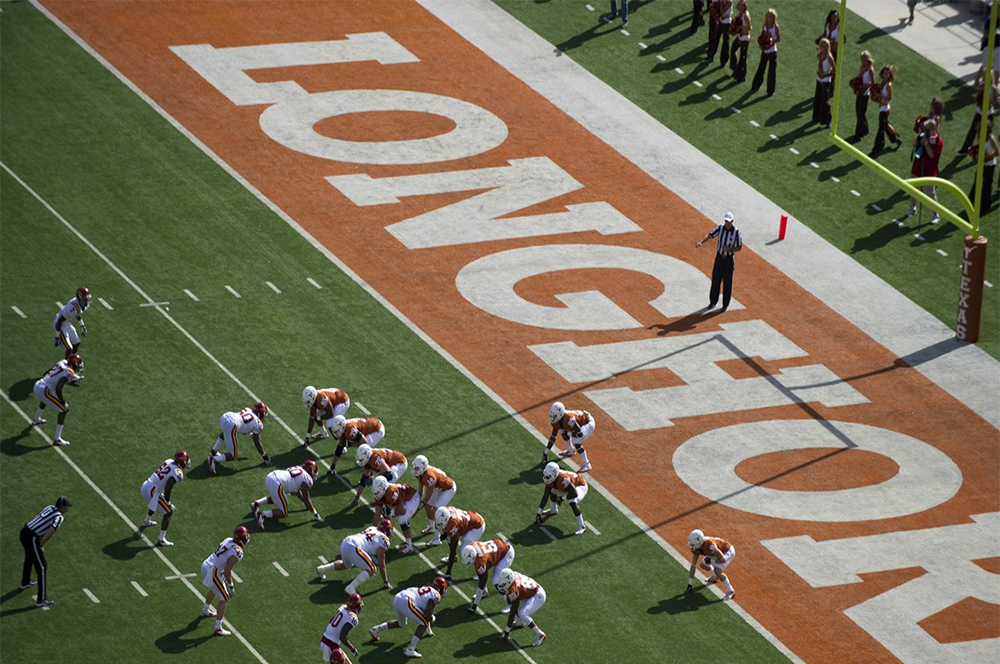The year 1968 was a turbulent one: Uprisings and social protests against war and oppression exploded throughout America and across the globe. Meanwhile, in the backyard of a 40-year-old assistant football coach from Port Aransas, Texas, another revolution was quietly taking shape — one that would unleash havoc on the gridiron and spawn an offense that would run roughshod over the sport of college football for the next two decades.
“To this day, it is an offense that cannot be defended,” legendary Notre Dame head coach Lou Holtz tells Sports Illustrated’s Tim Layden in Blood, Sweat and Chalk. He is referring to the Wishbone, a running-centered offense named for its three running backs lined up in a Y- or wishbone-shaped formation. The man who pioneered it, and used it to lead the University of Texas Longhorns to two national championships, was coach Darrell Royal. But back in the summer of 1968, even the running-inclined coach (“Three things can happen, and two of them are bad,” he famously said of passing) was oblivious to its potential.
"THE WISHBONE HAS BEEN LARGELY EXTINCT FOR NEARLY TWO DECADES."
Royal was far more concerned about improving on three consecutive four-loss seasons, culminating in Texas declining to attend the second-tier Bluebonnet Bowl after a disastrous 1967 season. During the off-season, Royal made a series of bold moves, including entrusting his offense to a linebackers coach named Emory Bellard, who had just one year of college ball under his belt. Royal had asked Bellard to devise an offense that would exploit the Longhorns’ three strong running backs, and so, in the sweltering Texas heat, the offensive coordinator put his young sons and their friends through a backyard drill to test the merits of his new Y-shaped attack.
The “Bone” depends on lightning-quick reads, options and deceiving the defense. With his three running backs — a fullback flanked by two tailbacks — the quarterback first puts the ball in the belly of the fullback, making a split-second read of the defensive tackle to determine whether to give up the ball or proceed to other options. If he keeps the ball, the quarterback sprints to the side, where again he chooses to keep the ball or give it up to his trailing tailback, while his other tailback leads as a blocker, or sometimes he might pass it to a wide receiver downfield. When executed well, the Wishbone can work against even the best defenses, keeping them off balance in their dizzying quest to ascertain who on the offense actually has the ball.
Later that summer, Bellard — a Texas coach straight out of central casting, with big-collared polo shirts, a tanned face and well-coiffed hair — moved his operation from the backyard to Austin’s Memorial Stadium, where a group of former players demonstrated the Wishbone for Coach Royal. It didn’t take long before Royal turned to his assistant and said, “Let’s go with it.” It was a brave move. “Royal was under intense heat from spoiled Texas alums,” says Layden. “For Bellard to suggest a virgin offense, virtually untested, was a mighty risk.”
Out of the gate, the Longhorns’ new offense looked dead on arrival. In the season opener, heavily favored Texas tied Houston before losing their second game to Texas Tech. Faced with an 0–1–1 record, Royal summoned his star senior, Bill Bradley, at 5:30 the next morning to inform him that the struggling quarterback would be replaced by a 5′11″, 170-pound backup, James Street, a quick but wiry junior known as the Rat. It was another risky move, but the Rat would win all 20 games he started, executing the Wishbone more masterfully than Bradley, and the Longhorns, averaging 39 points per game, would pull off an astonishing 30-game winning streak, including two national titles in 1969 and 1970.
With Royal and Texas leading the way, the Wishbone, as Layden puts it, went “sweeping through the sport like a Texas windstorm.” Over the next decade, seven national titles were won by Wishbone teams, including Oklahoma under Barry Switzer, and Alabama under Bear Bryant. And perennial college powerhouses like Nebraska and Colorado continued to run a version of it up through the 1980s and early 1990s. Even the NFL’s New Orleans Saints tried a version of the Wishbone in 1981, but it was quickly discontinued after veteran quarterback Archie Manning got smoked by a 22-year-old defensive terror named Lawrence Taylor.
Today, a handful of colleges run option-style attacks, but the Wishbone has been largely extinct for nearly two decades. The hypothesized reasons are plentiful: The Wishbone makes it tougher to come from behind and can be punishing on quarterbacks, or perhaps its grinding, often monotonous approach just isn’t sexy enough in an age of vaunted passing attacks and prized recruits. “I think it’s one word: recruiting,” says Holtz. “Once alumni started treating recruiting like it was a season in itself, it became very difficult. … All of a sudden, you couldn’t get a dominant quarterback, because you weren’t going to throw the football and get him ready for the NFL.”
A paradigm shift that undoubtedly has helped countless college defensive coordinators sleep more easily on Friday nights.

